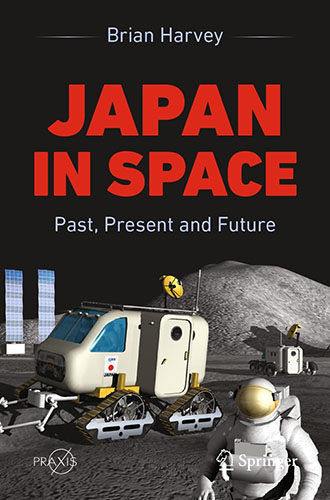Category: Non-Fiction
Reviewed by: Casey Suire
Title: Japan in Space: Past, Present and Future
Author: Brian Harvey
Format: Paperback/Kindle
Pages: 448
Publisher: Springer
Date: November 2023
Retail price: $37.99/$19.24
ISBN: 978-3031455711
Find this book
Last September, a small capsule from NASA’s OSIRIS-REx mission landed in the Utah desert. Inside the capsule were samples of the asteroid Bennu. As impressive as this sounds, OSIRIS-REx was only the first American asteroid sample-return mission. This incredible accomplishment was already done, not once but twice, by the Japanese spacecrafts Hayabusa and Hayabusa2.
The entire history of Japan’s space efforts is discussed in Brian Harvey’s Japan in Space. The book begins with the pioneering work of Hideo Itokawa, the father of Japanese rocketry. The target asteroid for Hayabusa, 25143 Itokawa, was named in his honor. By 1970, the first Japanese satellite, Ohsumi, was launched.
The development of Japan’s early launch vehicles is very interesting. Rockets such as the N-I and N-II were heavily based on America’s Delta family of launch vehicles. Eventually, the Japanese built and launched their own boosters. In addition to Hayabusa and Hayabusa2, a plethora of other deep space missions are described.
From 1969 to 2003, Japan’s national space agency was the National Space Development Agency (NASDA). Afterward came the Japan Aerospace Exploration Agency (JAXA). Another prominent organization in the book is ISAS, the Institute of Space and Astronautical Science. Formed in 1964 under the University of Tokyo, ISAS is now part of JAXA.
The chapter on Japanese human spaceflight is particularly interesting. The first three Japanese astronauts selected by NASDA were Mamoru Mohri, Takao Doi, and Chiaki Mukai. While this trio eventually all flew on the space shuttle, the honor of being the first Japanese astronaut goes to Toyohiro Akiyama. He was a journalist who visited the Mir space station in 1990. Akiyama’s mission, sponsored by the Tokyo Broadcasting System, was an early commercial spaceflight. The book also covers Japanese billionaire Yusaku Maezawa’s visit to the International Space Station (ISS) in 2021. To date, all Japanese astronauts have flown on either the Space Shuttle, Soyuz, or Dragon 2 spacecraft. There were plans to develop a spaceplane named HOPE for missions to the ISS, but this was eventually scrapped.
The later chapters cover current Japanese space developments in detail, which I found of particular interest. A few months after the book’s publication, Japan’s Smart Lander for Investigating Moon (SLIM) conducted a lunar landing. Despite landing upside-down, SLIM made Japan the fifth nation to reach the Moon. As for future lunar exploration, Japan signed the Artemis Accords in 2020. The book also mentions Japan’s new H3 launch vehicle. At the time of this writing, the H3 had its first successful flight. Private Japanese space companies are also covered. Planned future technological innovations are discussed as well, such as developing wooden satellites as a method to combat the growing threat of space junk.
Some of the spelling in the book is different from what American readers are used to. For instance, Japan doesn’t have a space program; it has a space programme. JAXA conducts launches at a space centre called Tanegashima. Some phrases are also written differently. Japan’s Soichi Noguchi was a member of the SpaceX Crew-1 mission. The book refers to this as the ‘Crew Dragon 1’ mission.
The author, Brian Harvey, is a veteran space writer with an impressive resume of published space books and articles. His first book was published in 1988. In addition to the Japanese, Mr. Harvey has also written about the Soviet, Chinese, and Indian space programs.
It’s not surprising, considering his nearly four decades of space reporting, that Harvey’s Japan In Space is an incredibly detailed work. His command of spaceflight terminology will probably cause many readers to falsely believe that he is an engineer or scientist. If you love reading every minute detail about every Japanese rocket, satellite, launch site, interplanetary mission, etc., this book is for you. If you are a novice space reader or prefer lighter details, you will most likely spend lots of time skipping certain passages in an effort to only get the main idea.
Harvey’s book is highly illustrated: 189 in color and 20 in black and white. From start to finish, this is a really solid space book. It’s perfect for readers, especially those in the West, who want to know what Japan has done and will do in space.
© 2024 Casey Suire



















